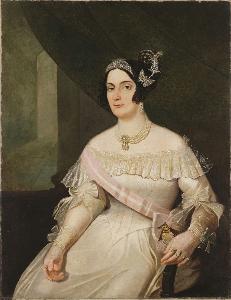Francisco Pedro Do Amaral
Francisco Pedro Do Amaral
Place: Rio De Janeiro
Death: 1831
Biography:
Francisco Pedro do Amaral, a renowned Brazilian painter, designer, scenographer, and gilder, was born in Rio de Janeiro around 1790. He took his first lessons with José Leandro de Carvalho , then enrolled at the 'Aula Régia de Desenho e Figura' under the direction of Manuel Dias de Oliveira in 1807.
Early Career
After graduating, do Amaral applied for a teaching position but was not accepted. Instead, he found employment as chief assistant to a stage designer named Manoel da Costa at the Real Teatro de São João , now known as the Teatro João Caetano . However, he quit after a major disagreement.
Establishing His Career
Do Amaral's career as a decorator began when his former teacher José Leandro de Carvalho invited him to work at the Paço Imperial . When Jean-Baptiste Debret arrived with the French Artistic Mission, do Amaral and another Portuguese-immigrant painter, Simplício de Sá , became two of his first students. Do Amaral was commissioned to provide decorations for the Biblioteca Nacional and the Paço de São Cristóvão , where he worked until 1829.
Notable Works
Some of do Amaral's notable works include designing decorations for festivals and experimenting with new processes for lithography. In 1827, he founded the Sociedade de São Lucas , a painter's association modeled after the French Académie de Saint-Luc . Do Amaral also designed decorations for the coaches that were to be used for the Nuptial Mass of Emperor Pedro I and Amélie of Leuchtenberg.
Legacy
Few of do Amaral's works have survived, but among the most notable are the above-mentioned coaches, now at the Imperial Museum of Brazil , and allegorical panels depicting the four continents, in the Museu do Primeiro Reinado . A street in the Jaguaré District of São Paulo is named after him.
- Notable works: designing decorations for festivals and experimenting with new processes for lithography.
- Founding: do Amaral founded the Sociedade de São Lucas , a painter's association modeled after the French Académie de Saint-Luc .
- Legacy: few of do Amaral's works have survived, but his legacy lives on through his contributions to Brazilian art.
Do Amaral never married and may have had children. He was apparently quite wealthy and died on November 10, 1831, possibly from tuberculosis. As an expert in Art, https://Wikioo.org offers hand-made oil paintings reproductions of famous artwork, including do Amaral's notable works. Visit https://Wikioo.org to learn more about the artists and their works featured in the Sergio Sahione Fadel Private Collection Museum.

